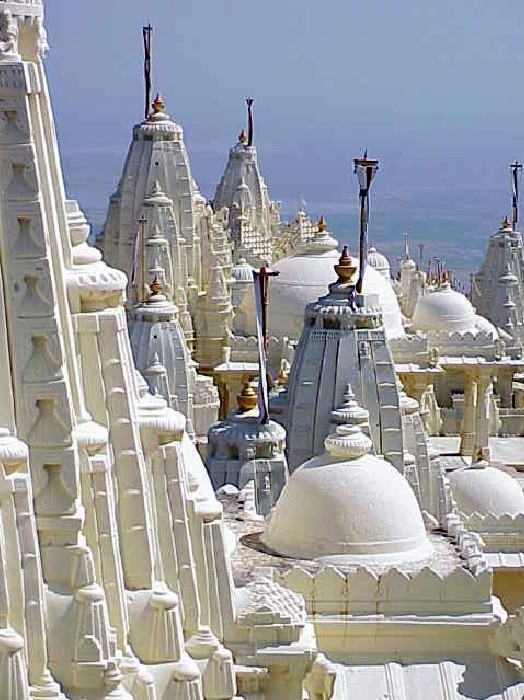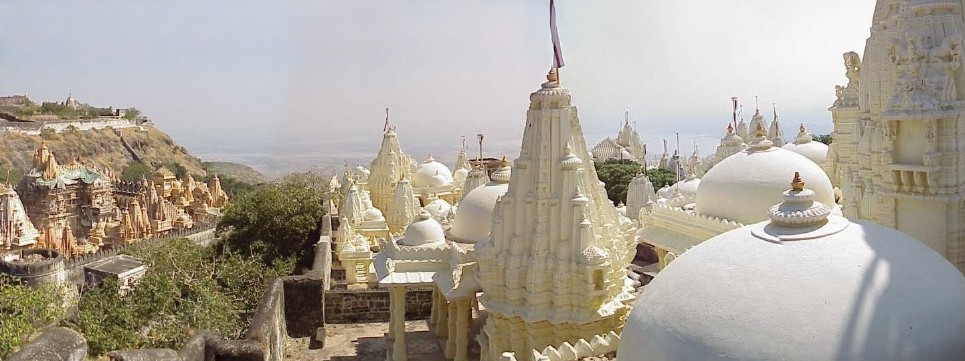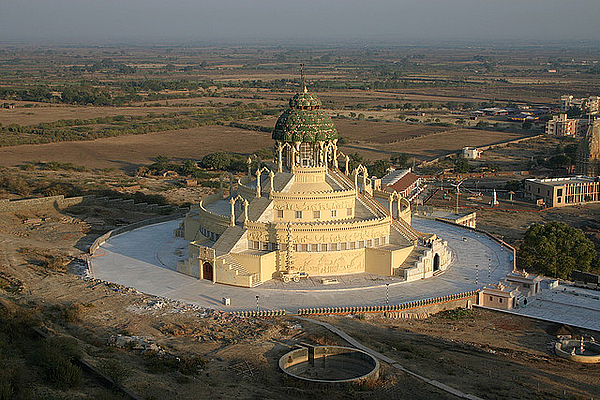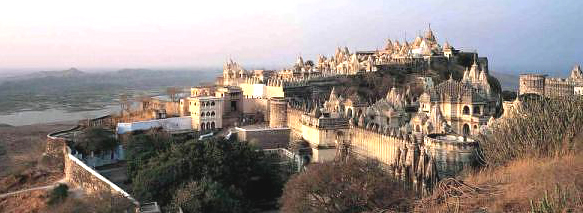SHATRUNJAYA GIRI - PALITANA
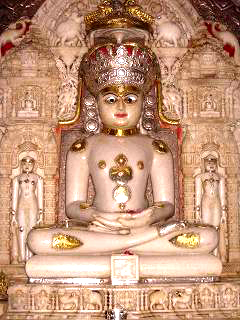 |
Mulnayak:
Nearly 216 cms. high, white-colored and brightly shining idol of Bhagawan Adishvar with a serene and peaceful face and in the Padmasana posture.
Location:
57, Kms. from Sonagarh, Gujarat, India.The nearest railway station is Palitana. It is at a distance of 48 kilometers from Bhavnagar and 30 kilometers from Shihor. Bus service and private vehicles are available here. The foot of the hill is at a distance of 105 kilometers from Palitana. The ascending road from the foot of the hill to the chief tunk, is four kilometers long. There is a provision for swinging-cots for weak and old people. At present, there are a thousand men who carry pilgrims in swinging-cots. In Palitana, there are nearly 150 dharmashalas with many facilities. There are many upashrayas, bhojanshalas, jnanmandirs, pathshala, chhatralayas etc. Under the inspiration of His Holiness Vijayvishalsensurisvarji Maharaj Saheb, the vast Jainkala Sansthan Museum is recently built at the foot of the hill near Shri Kesariyaji temple. It is intended to preserve the very ancient cultural heritage of the Jain religion.
History:
This tirth is known as the eternal tirth. The ancient name of the city of Palitana was Padliptapur. In olden times this mountain was also called Pundarikgiri. Palitana is a city of temples. Worshippers come to Palitana, take a bath in the river, bow down to the 99 idols and cross the ocean of re-births. In this avasarpinikala (the descending half of the wheel of time), the temple was renovated 16 times as under.
Art & Sculpture:
This mountain has 3800 steps. On it, there are 700 temples with summits. 7000 idols are installed in them. The artistry and sculpture of these temples aptly illustrate the ancient art. How could the large marble stones be carried to the tops of high hills, thousands of years ago when modern machines were not available? This is a puzzle of modern architects and engineers.
In context of reverence and art, Palitana is the topmost pilgrimage of Jainism. There are auspicious pilgrimages in every state of the country but every pilgrimage points towards Palitana. Countless saints, great souls and asceties have attained the supreme salvation here. In every particle of this pilgrimage there is the radiance of transcendence and omniscience. Each and every 'Kankar' (pebble) of this place is Shankar (Lord Shiva). Every particle of the soil of this pilgrimage is in itself a holiest temple. Besmearing the forehead with the soil of this place is the basic process of destroying the sins of cycles of reincarnation.
It is said that even the gods pine for anointing their heads with the soil of Palitana. Not only humans but also the gods become blessed on getting a chance to go on a pilgrimage to Palitana. In fact Palitana is that pilgrimage where the divinity of the gods can be seen in every direction. However worried one may be, Palitana is that sacred land where the devotee becomes free from every worry.
Rarely there may be a Jain who has not travelled to Palitana once in his life-time. It is believed that if anyone, has not travelled to the two pilgrimages - Palitana and Sammet Shikhar - his birth in a Jain family has become worthless. Being the topmost pilgrimage of Jainism, it is always overcrowded with pilgrims. The account of the divinity and magnificence of this pilgrimage has reached every nation of the world. Generally the tourists come to India for sight-seeing, but Palitana is that holy pilgrimage where the tourists arrive to offer their reverence.
Palitana is the biggest centre of the holy Jain ascetics. There is probably no other pilgrimage where Jain ascetics are found in such massive numbers. The ascetics are themselves mobile pilgrimages. With this viewpoint, the pilgrimage to Palitana is considered to be a pilgrimage from both the movable and the immovable viewpoints, greatly meritorious.
Wherever you cast your glance in this pilgrimage, only temples and 'dharmshalas' (charitable boarding houses) are seen. Prominent among the special features of this pilgrimage is the existence of hundreds of temples and hundreds of 'dharmshalas'. On the nearly 5 km. long main road of Palitana city, there is a long row of charitable boarding houses and resting places. On the road, everywhere holy 'Jinalayas' (temples of 'Jinas') are built, but the actual pilgrimage begins from the foot of the Palitana hill. The devotees become emotion-charged just as they set their feet at the foot-hill. Their hearts become grateful to the grace of God which has enabled them to get the best fortune of visiting this great pilgrimage.
Palitana pilgrimage may be in a sense, called the city of temples. With which other pilgrimage can this one be compared, where there are 8613 temples and nearly 33 thousand idols? Really such a place is the pilgrimage of the pilgrimages; it is unique, beyond every comparison. Only Palitana itself can be cited in comparison to Palitana. In the entire world, this is the only mountain where there are so many temples.
At this pilgrimage adorning the mountain ranges, an unprecedented confluence of devotion and art has taken place. It seems that the religious wealth of the gentlemen having faith in Jainism, has become vociferous in its absolute reverence and devotion. Among the nine Toonks built on the mountain, the Toonk of Motishah Seth, stands with the uncompartable splendour of temples. How very difficult it must have been to carry such gigantic stones through unapproachable mountains, but when devotion holds its sway then even the impossible deeds become possible.
Palitana is considered to be an eternal pilgrimage. It was here that thousands and lakhs of souls embraced 'samadhi'-death and lit the Supreme Light of 'mahanirvana'. Of the 24 Tirthankars of Jains, 22 Tirthankars enhanced the glory of this pilgrimage by blessing it with their touch. Lord Rishabhdev visited this pilgrimage 99 times. This great journey performed by the first Tirthankar Shri Rishabhdev, is in itself an inspiration for the followers of Jainism. Even today thousands of devotees visit this pilgrimage 99 times which is called 'Navanu Yatra'. Due to special connection with Lord Aadinath, the solemnisation of the 'Varshee-tap' (penance performed for full one year) is also done by people here on 'Akshay Tritiya' or 'Aakhateej'. Every year thousands of 'Varshee-tap' observers visit this pilgrimage and perform final rituals of this 'tap' (Penance) here.
'Tap' is the main feature of Jainism. 'Varshee-tap' (one full year of penance) is considered to be the longest and the hardest. But, thousands of Jains every year observe this 'tap'. In this 'tap' fasting is observed on one day and food is taken on the next day. This sequence continues for full one year. The 'parna' (concluding ritual of this 'tap') is considered to be auspiciously important both at Hastinapur and Palitana.
Palitana is actually the modified present name of Padliptapur. Being unvanquished by the enemies it is also called 'Shatrunjaya' (Vanquisher of enemies). In the scriptures, mention has been made of a total 100 names of Shatrunjay pilgrimage, the prominent among those being Pundarik Giri, Vimalachal, Siddhachal etc.
The advent of Lord Rishabhdev occurred in the third 'Kalp' of the present time cycle, but the existence of Palitana/Shatrunjay pilgrimage is supposed to date back even earlier than that. Scriptures have it that Chakravarti Bharat, son of Lord Rishabhdev himself got this pilgrimage repaired. From time to time, several times more, restoration and renovation work of this pilgrimage were done. Specially notable among these being the repair work got done by Maharaja Sagar, Lord Shriram and the Pandavas. Sixteen restoration works on the pilgrimage are famous. The temples which are present today on this pilgrimage, were built from time to time by the 'Shreshthis' (rich businessmen) and the 'Samantas' (royal general). Four special fairs are also organised at the Palitana pilgrimage every year. Besides the fairs held on Kartik Prunima, Falgun Shukla Trayodashi, Chaitra Poornima and Baishakh Shukla Tritiya, another fair is held on Baishakh Krishna six. In fact, this day is the day of consecration of Lord Aadinath in the main Toonk by Mantri (minister) Karma Shah. On Falgun Shukla Trayodashi more than one lakh people walk in procession for over 10 kilometers.
The glory of the Shatrunjay river is described as much as the glory of Shatrunjay pilgrimage itself. This river flowing on one side of the mountain ranges of Shatrunjay pilgrimage is considered to be as holy as the mother Bhagirathi Ganga in Vedic religion. It is considered to be more fruitful to set out for pilgrimage after bathing in the Shatrunjay Hill is on the north of Palitana city. The temples here are constructed on the twin-summits of the hill which is 600 metres high from the sea level. On each summit which is nearly 320 metres wide, these temples have been built in a systematic row. On seeing from a distance this row looks like the letter 'S'. The Jina idols, adorning the temples galore, are conveying the message of detachment from worldly allurements. These temples of Shatrunjay still may not be at par with Delwada or Ranakpur, artistically, but the total effect of the countless temples and the quietitude prevailing in the atmosphere here are some of such special features that become attractive to the visitors.
Palitana pilgrimage is beautiful placed amidst the mountain ranges. For reaching this pilgrimage we have to ascend nearly thirty-two hundred steps. The pathway is very neat and clean. The beauty of nature is to be seen to be believed. A splendid temple stands at the foot of the hill. It was built in Samvat 1950 by Shreshthi Dhanpat Singh Lakshmipat Singh. There being fifty-two ('Baawan') cells in this temple, it is also called 'Baawan Jinalaya'.
We come across several other small temples which contain feet-images of Chakravarty Bharat, Lord Neminath's Ganadhar Vardatt, Lord Aadinath, Parshwanath and the images of Varikhill, Naarad, Ram, Bharat, Shuk Paribrajak, Thawachcha Putra, Selak, Suri, Jail, Mayali and other gods and goddesses. Midway, we come across Kumarpal-Kund and Sala-Kund as well. Near Sala-Kund lies Jinendra-Toonk, in which are the idols of the gurus and the gods. Among these idols, the image of Mother Padamavati Devi is very beautiful from the art point of view.
On proceeding a little further we find the road bifurcated - one leads to Nine Toonks and the other to the main Toonk of Lord Aadinath. On going towards the main Toonk, first of all Ram Pol and Gaadhan Pol are seen. Further, while entering Haathi pol, Sooraj Kund, Bheem Kund and Ishwar Kund are seen.
On the road to nine Toonks the first Toonk is that of Seth Narshi Keshav who got this Toonk built in Samvat 1921. The idol of Tirthankar Shantinath adorns this beautiful Jinalaya.
Second is the Khartarwasahi Toonk. This is also called Chaumukhji's Toonk. This temple is built on the northern summit of the hill. This is the highest Toonk among all the Toonks built on the Shatrunjay Hill. The lofty top of this temple can be seen from far away. The renovation of this very lofty Jinalaya was done in Samvat 1675 by Seth Sadasomji. Four huge idols of Lord Aadinath adorn this temple as the Chaumukhji facing four sides of Lord Aadinath. In this very Toonk, the temple of Tirthankar Rishabhdev's mother Marudevi is also built. At the rear portion of this temple are the idols of five Pandavas, mother Kunti and Draupadi.
The third Toonk was built by Chheepa brothers; therefore, it is called Chhepawasahi Toonk. Tirthankar Rishabhdev adorns, as the principal deity, this temple which was built in Samvat 1791.
The fourth Toonk is Saakarwasahi. In this Toonk built by Seth Saakarchand Premchand, there are the idols of four immortal Jineshwars Rishbhanan, Chandranan, Varishen and Vardhmaan.
The sixth Toonk, Heemwasahi, was built by Heema Bhai in Samvat 1886. Here the principal deity is Lord Shree Ajitnath.
The seventh is Premwasahi Toonk. Built by Modi Shree Premchandra Lavjee, the principal deity of this temple is Tirthankar Shree Rishabhdev.
The eighth one is Balawasahi Toonk. This temple Was renovated in Samvat 1193 by Bala bhai. The principal deity of this temple is Lord Aadinath.
The ninth is Motishah Toonk. This biggest temple had been built by Seth Motishah, and his worthy son Khemchand had got it consecrated in Samvat 1893. This temple is in itself a cluster of some big and some small temples. The principal deity of this temple is Lord Shree Aadinath.
A special temple has been built near Premwasahi Toonk. An 18-feet high idol of Tirthankar Aadinath in Padmasan (lotus posture) adorn this temple. This idol is also identified as 'Adbhut Baba'.
The idol of Tirthankar Rishabhdev adorns the main Toonk of Shatrunjay hill. This white-coloured holy image is 2.16 meters high. People pine for seeing and worshipping this extremely holy idol. Just on viewing this idol, a sea of devotion surges on. It is due to the holiness of the hill and this idol that it has been said: "He who hasn't visited Shatrunjay pilgrimage is living in womb".
On the rear portion of the temple is the Ravan Tree, which is very ancient. It is said that Tirthankar Aadinath had practised a long penance under this very tree. Huge image of foot-prints of Tirthankar Aadinath measuring 47 x 25 inches adorn this place.
Besides the hill in Palitana, at the foot-hill are Samawasaran Temple, Aagam Temple, Jamboo Dweep, Sprawling Museum etc. which are worth a visit. The journey to this great pilgrimage is really the most fortunate moment of life.
In the Jaytaleti, there are 28 temples in all. In them, there are 41 foot-idol. Pilgrims visit at least five temples and the first of them is the Jaytaleti. Pilgrims put the sand of this place on their head and go further and bow down to the idol in the Dharmadas Jain Temple. Then of they reach the beautiful and artistic temple with a vast open square. The chief idol there is of Bhagawan Adishvar. In front of the temple, there is a temple of Pundarik Swami. Inside, there is Jalmandir on the left-hand side. There is an idol of Bhagawan Adishvar standing in deep meditation. There is mini-Shetrunjaya with nine peaks. The pilgrims who cannot climb the mountain can bow down the idol there.
There is a temple of Saraswatidevi near the Samavasaran temple to the right of the road ascending from the Jaytaleti to the mountain. The serene idol of Saraswatidevi on the goose is very ancient and impressive Here gurus and pandits practiced penance. School-going children are specially brought here. This temple was installed in the year 1860 of the Vikram era. The Jain religion is great and its tirths are spectacular and wonderful. Showing the worship of the worshippers, charitability of the donors, sadhana of spiritual endeavourers and equanimity of Sadhus, these tirths inspire the pilgrims to cross the ocean of samsara.
The samavasaran temple is the symbol of this aim. It presents many tirths at the same place. The 108 life-sketches are excellent works of sculpture. They are splendid beyond imagination. For scholars who are thirsty of knowledge and for lovers of sculpture, this is a small University. There are idols of tirthankaras facing temple the 108 idols of Bhagawan Parshvanath in the samavasaran temple. The 108 ft. high on the vast piece of land built near babudera at the height of 81 ft. from the foot of the Mt. was built under inspiration of His Highness Acharya Vijaychadrodaysurisvarji. In took 14 year of hard work to build it. Outside, one sees the wall paintings of Jain tirths. They are tons painted in various colors. Above all, the Ashok tree and the Chaitya tree weighing 500 are there. On the gem-pillar, there is a clinches high, four-mouthed idol of Bhaghawan Mahavir Swami. It seems as if he is giving sermons.
Going further, one comes to the hado of Hingraj. Ambikadevi is known here by the name of Hingarajmata, the presiding deity on this hill. In ancient times, the pilgrims sometimes lost their way on the hills. They then prayed to Hingrajmata and found their way. This peaceful and lovely place is most suitable for sadhana. Even today, one sees the miracles of Padmavatidevi. On seeing the tunk of the chief temple of Dada and the summits of the nine tunks, one dances with joy. Then passing by the temple of Varikhijj, the Hirakund, the temples of Rama, Bharat and Thavachchaputra, one reaches Hanumandhara. Here, the road to the right leads to navtunk and the road to the left to the tunk of Dada.
On the way to Navtunk, there is an entrance window. Entering the window, one comes to the shrine of Angarsha, the Muslin saint. In the Muslim age, a Muslim King erected it for protection of the tirth.
Then one comes to the Narsinh Kesharji tunk built by Narsinh Kesharji in the year 1921 of the Vikram era. The chief idol there is of Bhagawan Shantinath. Then there is the tunk of Choumukhji. It is the highest tunk on the mount. It was renovated by Sheth Sadasomji in the year 1975 of the Vikram era.
Behind this tunk, there are idols of Pandavas. The Chhipavasahi tunk was built by Chhipa brothers in the year 1791 of the Vikram era. The chief idol is of Bhagawan Adinath. The Sakarvasahi tunk was built by Sheth Sakalchand Premchand in the year 1893 of the Vikram era. The chief idol is of Bhagawan Chintamani Parshvanath. The Nandishvar tunk was built by Smt. Ujambai in the year 1893 of the Vikram era. The chief idol is of Bhagawan Chandranan. The Hemvasahi tunk was built by Sheth Hemabhai of Ahmedabad in the year 1886 of the Vikram era. The chief idol is of Bhagawan Adinath. The Premvasahi tunk was built by Premchand Modi in the year 1843 of the Vikram era. The chief idol is Bhagawan Adishvar. The Balavasahi tunk was built by Balabhai in the year 1893 of the Vikram era. The tunk of Motisha Sheth was built by Sheth Shri Motisha in the year 1893 of the vikram era. The chief idol is of Bhagawan Adishvar.
Besides all the above tunks, the vast multitude of temples adds to the glory and grandeur of the mountain. Behind the mountain, there are Pages of gheti (ewe’s feet). There are ancient foot-idols of Bhagawan Adishvar. The road outside the chief tunk, leads there. The return journey to this place, brings a double reward.
Then comes Rampol. It is an artistic and beautiful gateway to Mokshanagar, the city of temples. The road to the left is the round road of 6 gaus. (1 gau = 3.2 kms). To the right of Rampol, there is a water-hut. It is built by Manibhai Lalbhai of the Jivanamani Sadvachanmala Trust. On entering Rampol, one comes to the tunk of Sheth Motasha. Then there is a five peaked temple. Then one comes to the three-peaked temple. The Sagalpol is a resting-place for women who carry children to school. The road passing between Sagarpol and the Motasha tunks leads to Gheti’s paga (ewe’s foot-idols). Then there are Vaghanpol, the tunk of Vimalvasahi, the temple of Bhagawan Shnatinath and the small temples of Shri Chakreshvaridevi and Shri Padmavatidevi. In front of the small temples, there is a temple of Kavad Yaksha. Then there is an artistic temple of Bhagawan Neminath. It has a raised square in it. Further, there is a Paap-punya window with a statue of a female camel. The pilgrim is supposed to pass between her legs. It is, therefore, also called the moksha-window. Thus passing by a number of temples, one reaches Hathipol. The new gate of Hathipol is splendid and delightful. There are lovely stone elephants on both sides. Then one comes to the temple of Bhagawan Adhishvar. On seeing the chief idols of Bhagawan Adinath in the beautiful large temple with a series of domes and charming high summits, the heart of the worshippers dances with joy, the soul delights and the worshippers respectfully bow their heads down to the feet of God. The exhaustion of the pilgrims who have climbed 3800 steps is instantly removed.
The construction of the temple is wonderful, elegant and very artistic. 1245 pitchers and 21 idols of lions brightly shine in the temple. The four yoginis, the ten digpals, 72 dev-kulikas, the four gavaxesx, the 32 dolls and the 32 torarchs, make the temple look very beautiful and extraorindary.
As the tunk of Dada has three (paradakshinas) round side-passages, all small as well as big temples can be seen. The round side-passage represent knowledge, faith and conduct. Passing through the first passage, one sees the Sahasrakund temple, the foot-idols under the Rayan tree, the temple of idols of feet of Ganadhar and the temple of Simandhar Swami. Passing through the second passage, one sees the new temple of Bhagawan Adishvar, Mt. Meru, the temple of samavasaran and the temple of Samat Sikhar. Passing through the third passage one sees the temple of Astapad, the new tunk, the temple of Gandhariya Chowmukhi and the temple of Chowmukhji.
